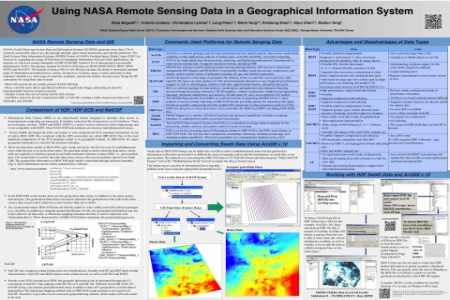Ross Bagwell, Francis Lindsay, Christopher Lynnes, Long Pham, Wenli Yang, Peisheng Zhao, Aijun Chen, MuQun Yang
NASA’s Earth Observing System Data and Information System (EOSDIS) generates more than 2 Tb of remotely sensed data each day through multiple spacebasedinstruments and satellite platforms. The Earth Science Data Information Systems (ESDIS)project at the NASA Goddard Space Flight Center (GSFC) is focused on expanding the usage ofEOS data in GIS applications, for both scientists and the general public – especially whenscience quality satellite products are readily obtainable in HDF-EOS format. The primaryformats for NASA’s EOS data are NetCDF, HDF4 (HDF-EOS2), and HDF5 (HDF-EOS5), ofwhich the Federal Geospatial Data Committee (FGDC) only endorses NetCDF (out of a total of64 external standards).The benefit of using a GIS includes the ability to interrelate multiple typesof information assembled from a variety of sources to visualize, query, overlay, and analyze data,making it valuable to a wide range of scientific, academic and private entities. Some of the issuesfacing the remote sensing community for using these data include:
- Most GIS systems do not readily process or are unable to utilize NASA Remote Sensing (RS)data
- Many scientific users utilize specialized software to geolocate images, which presents aproblem for interoperability between common systems- Headers in data files are not easily read by GIS systems
- Key NASA datasets are mostly available in either HDF-EOS or NetCDF formats
- GeoTIFFs cannot be directly created from HDF or NetCDF, creating a multi-step process thatis not inherently user friendly (including reprojection, band extraction, and exporting)
With that in mind, EOSDIS has undertaken a number of steps toward aiding the use of these databy the broader GIS community:
- Support raster data geometry and integration of EOS data into a GIS, with functions for imageprocessing, modeling, and spatial analysis
- Leverage relationships throughout the GIS community to enable the use of NASA RS data on the most commonly used platforms, focusing primarily on NetCDF, HDF4, and HDF5
- Meet the needs of scientists to enable them to use GIS as a tool to augment their work in thevarious communities by providing them with capabilities to translate, process, or analyze the datain a more common and cost-effective GIS that is more interoperable with other communities
- Assist the GIS community with understanding how to access and utilize EOS RS data in morecommonly known and easily available GIS packages.
Submitted by: Ross Bagwell, NASA Goddard / CTS


